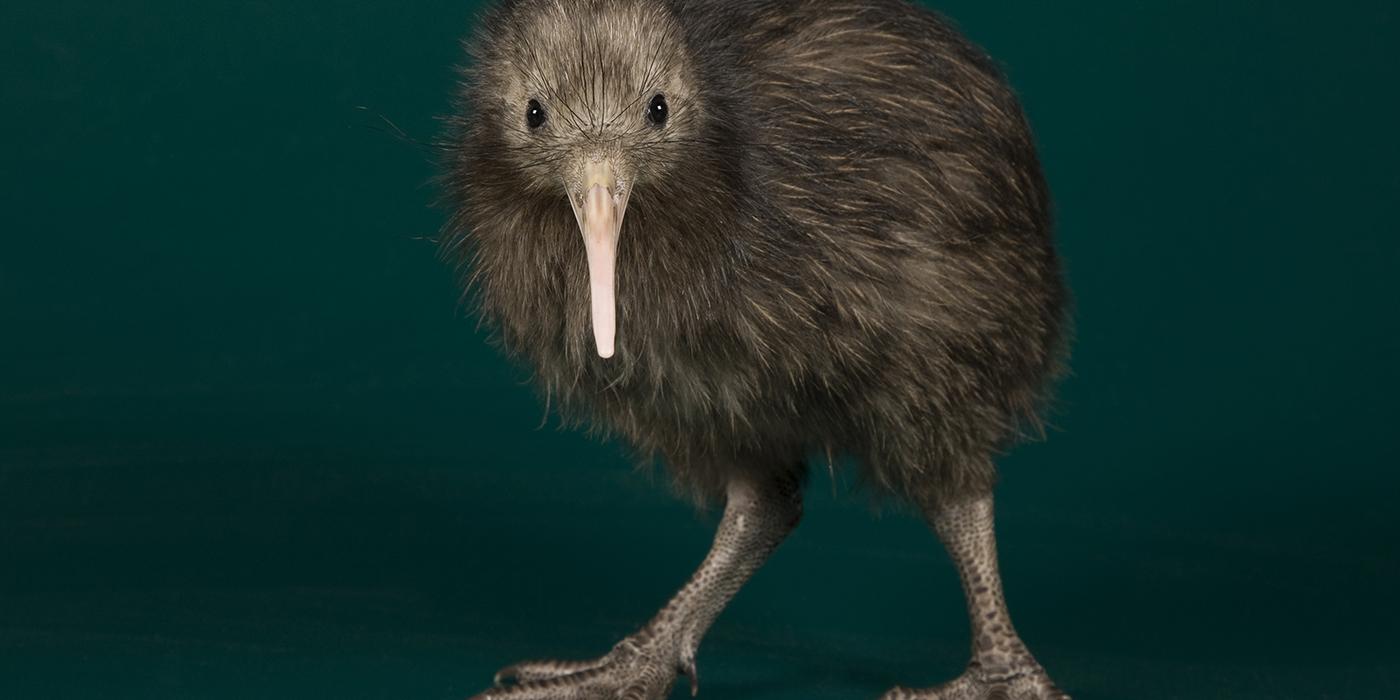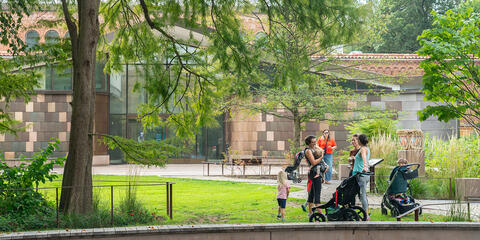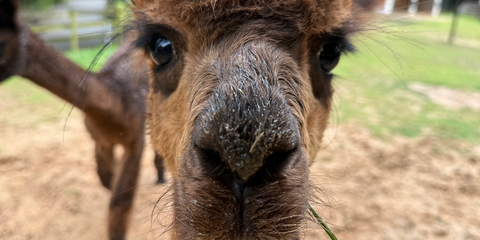Physical Description
Kiwi are the smallest of the ratites, a distinct group of large, flightless birds. Feathers resembling a shaggy coat of brown hair cover the kiwi's body. The kiwi's long, curved, pale gray-brown bill is unique in the bird world in having the nostrils located near the tip. They smell their prey rather than see it. Though their eyes are small, their ears are unusually large.
Size
Kiwi are stout birds, standing 1.5 to 2 feet tall (0.5 to 0.6 meters) tall with females at 4.5 to 8.5 pounds (2 to 3.9 kilograms) weighing more than males at 3 to 7 pounds (1.4 to 3.2 kilograms).
Native Habitat
Kiwi are native to New Zealand. The kiwi's original habitat was moist coniferous forest dominated by kauri and tree ferns. The clearing of most of this primeval forest has forced many kiwi to attempt to survive in partially timbered agricultural areas. The largest remaining population of brown kiwi on North Island resides in a large commercial pine plantation. Territories range in size from 12 to 124 acres (5 to 50 hectares) depending on the quality of the habitat. Kiwi excavate several burrows within each territory. A typical underground burrow has one entrance, a tunnel 0.7 to 6.5 feet (0.2 to 2 meter) long and a terminal chamber large enough to accommodate both birds. They also use hollow logs or shallow holes dug between tree roots.
Communication
The name kiwi is derived from the ringing call of the male. Females respond with a hoarse throaty call, which has been likened to the sound caused by opening an extremely old rusty barn door. These calls allow the pair to mark their territories and remain in contact while foraging separately. Both sexes can produce an assortment of grunts, growls, and hisses and often snuffle audibly when searching for food. The snuffling may be produced by the opening and closing of a valve behind the nostrils that prevents the bird from inhaling dirt and debris as it probes the soil and leaf litter.
Food/Eating Habits
Brown kiwi have an extremely varied diet that includes earthworms, beetles, snails, crayfish, insects, fruits and berries. They use their unique bill to sniff out food, as the bird forages by plunging it repeatedly into the leaf litter of the forest floor in search of prey.
At the Smithsonian's National Zoo, they are fed pellets, mixed vegetables, natural balance, mealworms and earthworms.
Sleep Habits
Kiwi are nocturnal birds. They forage actively from dusk to dawn.
Reproduction and Development
Kiwi nests are usually located in well-established burrows where the surrounding foliage has had time to grow up and thoroughly conceal the entrance. The female lays a single extremely large egg—an average of 15 percent of her body weight. Producing such a large (about 1 pound) and energy-rich (over 60 percent yolk) eggs depletes the female's energy reserves. It takes the female 25 to 36 days between the laying of the first and second egg. She then leaves the male to incubate the eggs, which takes about 68 to 91 days. Kiwi chicks have no egg tooth and must use their feet to kick their way out of the shell. They are fully developed chicks, looking like a miniature replica of an adult.
Although most species are completely independent by four weeks of age, they do not reach adult size until they are 18 to 20 months old.
Conservation Efforts
The kiwi has long been the cherished national emblem of New Zealand. Though they have enjoyed complete legal protection since 1896 and large tracts of pristine forests have been set aside in parks and reserves, their numbers are dropping by about six percent each year. In 1996, scientists estimated the North Island brown kiwi population at 35,000 birds.
New Zealand was an island without large predators until European settlers introduced a variety of predatory species, both deliberately and accidentally. As some species of birds evolved in the absence of predators, they lost the power of flight. Up until that point the only mammals found on New Zealand were three species of bat (one is now extinct).
While adult kiwi are usually feisty enough to defend themselves against the smaller predators, their eggs and newly hatched young are extremely vulnerable to predation. Predators include rats, weasels, cats, dogs and pigs.
Timeline of Kiwi Conservation at the Smithsonian's National Zoo and Conservation Biology Institute
- 1968: The government of New Zealand gives the Smithsonian’s National Zoo a pair of brown kiwi as a gift. The kiwi were presented by Prime Minister Keith Holyoake.
- 1975: The Zoo becomes the first organization to hatch a brown kiwi outside of New Zealand. The Zoo names him Toru which means “three” in Maori.
- 1989: The Zoo launches its Meet-a-Kiwi program, where visitors can observe a kiwi up close and learn about the Zoo’s partnership with conservation organizations. The program launches with male kiwi Baxter as the educational ambassador for his species. The Zoo has the only such kiwi program in the country. The Meet-a-Kiwi program now includes a kiwi ambassador at the Smithsonian Conservation Biology Institute (SCBI) as well as the Zoo.
- 1991: Male kiwi Maori arrives at the Zoo from New Zealand.
- 2005: Zoo animal keeper Kathy Brader becomes the Association of Zoos and Aquariums’ (AZA) Species Survival Plan coordinator and the studbook keeper for all brown kiwi outside of New Zealand. In this role, she matches kiwi and their mates by considering factors such as health, sexual maturity, breeding capability and personality.
- April, 2005: The Zoo acquires female brown kiwi Nessus from the Brookfield Zoo as part of the AZA Species Survival Plan for Brown Kiwi.
- 2006: SCBI geneticists develop a novel way to sex brown kiwi chicks by testing DNA samples swabbed from inside the egg of the hatched kiwi.
- February 13, 2006: The Zoo hatches its second brown kiwi, a male named Manaia. Manaia’s parents are Maori (father) and Nessus (mother).
- March 7, 2008: The Zoo hatches its third brown kiwi. The chick’s parents are Maori (father) and Nessus (mother).
- April 2008: The male kiwi chick born in March 2008 is named Koa via an online public vote. Koa means “happy and jubilant” in Maori, New Zealand’s official indigenous language.
- March 30, 2010: The Zoo hatches its first female and fourth-ever brown kiwi and the New Zealand Ambassador to the United States, Roy Ferguson, names her Hiri, which means “important and great” in Maori. The birth is significant for the population--there are only 12 female brown kiwi in zoos outside of New Zealand.
- 2010: New Zealand gifts 11-year-old male Ngati Hine Tahi and 11-year-old female Ngati Hine Rua to the Smithsonian’s National Zoo and Conservation Biology Institute to establish a kiwi breeding facility at SCBI in Front Royal, Virginia. This is the first export of brown kiwi in 19 years.
- 2010: The Zoo launches a kiwi feather repatriation program. Kiwi feathers are considered “taonga” or “treasure” to the Maori and are protected. Since 2010, the Zoo has collected shed kiwi feathers and sent them to New Zealand’s Dept. of Conservation who turns them over to the Maori. It’s possible that weavers incorporate the feathers to repair old “Kahu Kiwi” (kiwi cloaks) or for other special projects.
- June 15, 2010: The second female brown kiwi—and fifth kiwi ever—Aerta is born on at the Zoo to parents Maori (father) and Nessus (mother).
- July, 2010: Ambassador Roy Ferguson and Consul General John Mataira bless Ngati Hine Tahi and Ngati Hine Rua in a blessing ceremony at SCBI’s new kiwi breeding facility in Front Royal, Virginia. The two kiwi will introduce entirely new genes into the population.
- Fall 2010: Ngati Hine Rua and Ngati Hine Tahi produce their first fertile egg at SCBI. The embryo dies at two or three weeks of age.
- February 14, 2011: Zoo loses female kiwi Aerta without signs of clinical illness. She was born in June 2010 to parents Maori (father) and Nessus (mother).
- December 11, 2011: A sixth brown kiwi, a female, successfully hatches at the Zoo. Mike Moore, New Zealand Ambassador to the United States names the kiwi Omana in honor of his hometown, O-Manawatere, a township located southeast of Auckland. Only 15 females and 33 male kiwis live in zoos outside of New Zealand. Omana’s parents are to parents Maori (father) and Nessus (mother).
- 2012: Zoo animal keeper Kathy Brader wins the AZA 2012 Plume Award from the Avian Scientific Advisory for Exceptional Individual Achievement in Avian Husbandry for her commitment to brown kiwi breeding and management in North America.
- March 7, 2012: The Zoo hatches its seventh brown kiwi chick, Pip. He is the last kiwi offspring from parents Nessus and Maori who produced a total of six chicks at the Zoo. Pip became the Zoo’s “Kiwi Ambassador” for the Meet-A-Kiwi program in May 2014.
- March 11, 2012: SCBI hatches its first brown kiwi chick, a male. Keepers name him Pokey. He was hatched from an egg transferred from Columbus Zoo for incubation. On recommendation from the kiwi Species Survival Program, Pokey was sent to Alphen Zoo in the Netherlands for breeding.
- May 26, 2012: Male Manaia, dies without exhibiting warning signs of clinical illness.
- October 12, 2012: National Zoo Director Dennis Kelly repatriates kiwi feathers from the Zoo as well as other zoos across the United States and Europe to the Embassy of New Zealand in a Maori ceremony, strengthening the Zoo’s role in New Zealand’s conservation and cultural recovery efforts.
- 2013: There are now 53 kiwi in 13 institutions across North America, Europe and Asia, all of which are part of AZA’s Species Survival Plan for brown kiwi, managed by Kathy Brader.
- January 1, 2013: New Zealand’s Prime Minister John Key appoints Zoo animal keeper Kathy Brader as Honorary Member of the New Zealand Order of Merit, recognizing her devotion to kiwi public education and outreach, as well as her success in breeding these unique birds and propagating the species.
- January 31, 2013: SCBI hatches its second brown kiwi chick, a female. Keepers name her Manawa Ora, which means “hope” in Maori. Manawa Ora was hatched from an egg transferred from Columbus Zoo for incubation.
- April 26, 2014: At six years of age, the Zoo’s brown kiwi Koa dies without exhibiting any signs of clinical illness. Koa served as a kiwi ambassador for the Meet-a-Kiwi program since 2012.
- October 30, 2015: At 19 years of age, female brown kiwi Nessus dies. Nessus and Maori produced six chicks during her life at the Zoo. Their offspring serve a vital role in breeding, research and as ambassadors for their species.
- January 2016: Toru, the kiwi to become the first-ever hatched at the Zoo in 1975, celebrates his 41st birthday.
- May 10, 2016: SCBI’s Ngati Hine Tahi and Ngati Hine Rua become first-time parents with the hatching of their first chick. After Ngati Hine Rua laid the egg, Iwi, another male kiwi living at SCBI, incubated it for 30 days before keepers moved it into a meticulously climate-controlled incubator where it finished developing. Although Ngati Hine Rua had laid many eggs since 2010, it wasn’t until the male, Ngati Hine Tahi lost some weight that they were able to successfully breed and hatch a chick.
- June 1, 2016: Male kiwi chick hatches at the Smithsonian Conservation Biology Institute to parents Ngati Hine Tahi (father) and Ngati Hine Rua (mother).
- July 31, 2016: Male kiwi chick hatches at the Smithsonian Conservation Biology Institute to parents Ngati Hine Tahi (father) and Ngati Hine Rua (mother).
- Sept. 30, 2016: A fourth egg is found from breeding pair Ngati Hine Tahi (father) and Ngati Hine Rua (mother).
Help this Species
- Support organizations like the Smithsonian’s National Zoo and Conservation Biology Institute that research better ways to protect and care for this animal and other endangered species. Consider donating your time, money or goods.
- Share the story of this animal with others. Simply raising awareness about this species can contribute to its overall protection.




